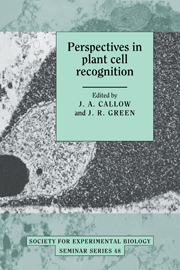Book contents
- Frontmatter
- Contents
- List of contributors
- Preface
- Sexual signalling in Chlamydomonas
- Gamete recognition and fertilisation in the fucoid algae
- The fungal surface and its role in sexual interactions
- Gamete recognition in angiosperms: model and strategy for analysis
- The molecular biology of self-incompatible responses
- Cell surface arabinogalactan proteins, arabinogalactans and plant development
- Local and systemic signalling during a plant defence response
- Contact sensing during infection by fungal pathogens
- The electrophysiology of root–zoospore interactions
- Molecular differentiation and development of the host–parasite interface in powdery mildew of pea
- Recognition signals and initiation of host responses controlling basic incompatibility between fungi and plants
- Cell surface interactions in endomycorrhizal symbiosis
- Host recognition in the Rhizobium leguminosarum–pea symbiosis
- The Rhizobium trap: root hair curling in root–nodule symbiosis
- Structure and function of Rhizobium lipopolysaccharide in relation to legume nodule development
- Index
- Plate section
The fungal surface and its role in sexual interactions
Published online by Cambridge University Press: 07 May 2010
- Frontmatter
- Contents
- List of contributors
- Preface
- Sexual signalling in Chlamydomonas
- Gamete recognition and fertilisation in the fucoid algae
- The fungal surface and its role in sexual interactions
- Gamete recognition in angiosperms: model and strategy for analysis
- The molecular biology of self-incompatible responses
- Cell surface arabinogalactan proteins, arabinogalactans and plant development
- Local and systemic signalling during a plant defence response
- Contact sensing during infection by fungal pathogens
- The electrophysiology of root–zoospore interactions
- Molecular differentiation and development of the host–parasite interface in powdery mildew of pea
- Recognition signals and initiation of host responses controlling basic incompatibility between fungi and plants
- Cell surface interactions in endomycorrhizal symbiosis
- Host recognition in the Rhizobium leguminosarum–pea symbiosis
- The Rhizobium trap: root hair curling in root–nodule symbiosis
- Structure and function of Rhizobium lipopolysaccharide in relation to legume nodule development
- Index
- Plate section
Summary
Introduction
The fungi exhibit a polyphyletic range of sexual differentiation, with a variety of mating systems promoting genetic exchange and gene flow (see Carlile, 1987; Prillinger, 1987). This review considers examples of the biochemical and cytological mechanisms of fusions of cells of different mating types (Table 1).
Membrane fusion of motile gametes
Allomyces macrogynus, a member of the Chytridiomycetes, produces five types of flagellate cell in its life cycle: male and female gametes, the resultant zygote, and haploid and diploid zoospores. Of these, fusion occurs only between a male and female gamete. Both gametes are motile by means of one posterior flagellum, but there are many differences between them that must be phenotypic sexual differences, since they are both produced by the same haploid plant and must be isogenic. Only the female produces the chemotactic attractant, sirenin, and only the male (the spermatozoid) is attracted by it (Carlile & Machlis, 1965; Pommerville, 1978, 1981). Likewise, but less obviously, the male produces an attractant, parisin, which attracts the female (Pommerville & Olson, 1987). Sirenin is a sesquiterpene (Fig. 1d) and parisin shows similar chemical characteristics. The male gamete swims much more actively than the female, is bright orange with an accumulation of γ-carotene, is much smaller than the female, and has fewer and smaller mitochondria (Fig. 1a,b). It also appears to lack the ‘sidebody complex’ or ‘Stüben body’, a complex of lipid granules and microbodies of unknown function that is present in the female, and has fewer γ-like particles (Pommerville & Fuller, 1976).
- Type
- Chapter
- Information
- Perspectives in Plant Cell Recognition , pp. 33 - 58Publisher: Cambridge University PressPrint publication year: 1992
- 6
- Cited by

